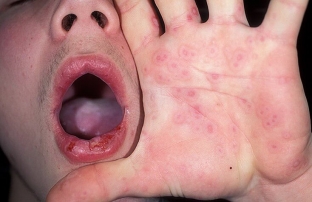The appearance of rashes on the skin – This is a common occurrence that every person encounters from time to time. Bubbles, pustules, spots and many other elements often appear in small quantities and disappear on their own after a short time. But in some cases, rashes can be a sign of a serious pathological process that develops in the body. One of these diseases is erythema multiforme, which is characterized by a large number of polymorphic skin rashes. Why does this pathology develop, and what are the features of its clinical picture – read on estet-portal.com in today's article.
Erythema multiforme: features of the clinical picture
Erythema multiforme – it is a dermatological disease that affects skin and, often, mucous membranes. An acute inflammatory process is characterized by the appearance of a sufficiently large number of various inflammatory elements.
The disease can occur at any age, but most often affects young people aged 18-21, as well as children after 5 years.
Erythema multiforme has a predominantly cyclic course, is equally prone to both exacerbations and self-healing. The presence of inflammatory elements significantly impairs the quality of life of the patient, and therefore the pathology requires competent diagnosis and timely treatment.
Erythema multiforme:
- why does erythema multiforme occur: main causes;
- classification of erythema multiforme: main options;
- Clinical presentation of erythema multiforme: characteristic features.
Why does erythema multiforme occur: the main causes
At the moment, there is no single proven etiological factor in the development of erythema multiforme. It is believed that the pathological process is polyetiological, but has a single development mechanism. Presumably, with erythema multiforme, there are genetically determined changes in the immune system, which lead to its hypersensitivity and inadequate response to antigen exposure. The immune system perceives skin cells damaged by antigen as foreign proteins and tries to destroy it. It is this version of the development of the inflammatory process that is the most popular today.
Classification of erythema multiforme: main options
There are several main classifications of erythema multiforme, depending on the underlying factor, the severity of the disease and the characteristics of its clinical picture.
According to the type of implementing factor, the following are distinguished:
- an infectious form that can be provoked by viral or bacterial agentsand;
- toxic-allergic form, most often developing after the use of certain drugs.
Depending on the severity of the patient's condition, erythema multiforme is classified into:
- light – this form proceeds without pronounced disturbances in the general condition of the patient;
- heavy – this form is characterized by the presence of widespread rashes on the skin and mucous membranes, as well as varying degrees of severity of violations of the general condition of the patient.
According to the characteristics of the clinical picture, erythema multiforme is:
- spotted;
- papular;
- maculopapular;
- vesicular;
- bullous;
- vesiculobullous.

Clinical presentation of erythema multiforme: characteristic features
The features of the clinical picture of erythema multiforme depend on its form. With infectious polymorphic erythema, the disease begins acutely, is characterized by the jerky appearance of rashes that look like small bright pink spots of a rounded shape, rising above the skin due to an edematous roller. They grow rapidly, reaching a diameter of up to 20 mm. Simultaneously with the spots, a nodular-papular rash of the same size appears, which has a clear outline. After 1-2 days, spots and papules in the center change color to brownish or cyanotic, and remain the same on the periphery. Between these two zones is a pale raised corolla. Further, in the center of the elements, vesicles with a dense lid and liquid content are formed, which subsequently shrink to form bloody crusts in the center of the elements. Quite often they rupture with the formation of an erosive surface with a bloody crust. On average, the resolution of all elements of the rash lasts 5-12 days.
In the toxic-allergic form, the spots have a brighter color, blisters with a dense cover often form on the face, often the elements are larger and do not resolve for a long time. With this form, inflammatory elements are almost always formed on the mucous membranes.
Erythema multiforme – it is an acute inflammatory process, characterized by the presence of polymorphic rashes on the skin and mucous membranes.
Quite often, it is precisely this feature of the pathology that makes its diagnosis difficult. But it is a timely and correctly established diagnosis that determines the effectiveness of the treatment of erythema multiforme. estet-portal.com thanks you for your attention.
See also: "Erythema nodosum: why diagnosing the underlying disease is important".









Add a comment